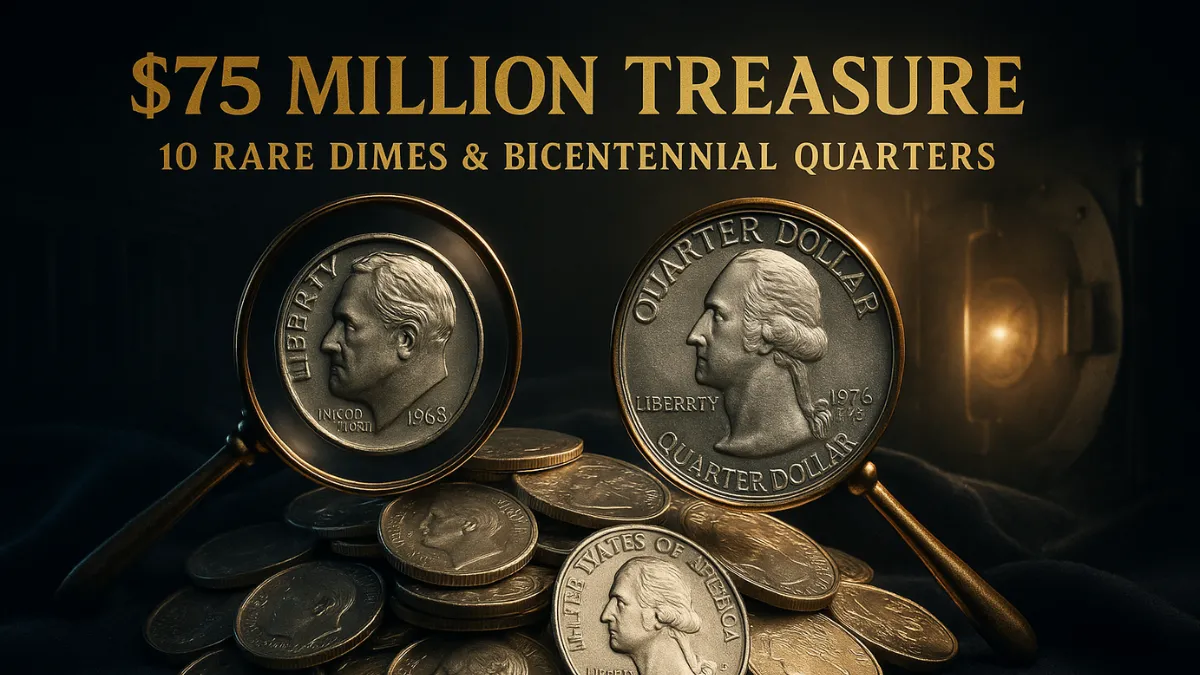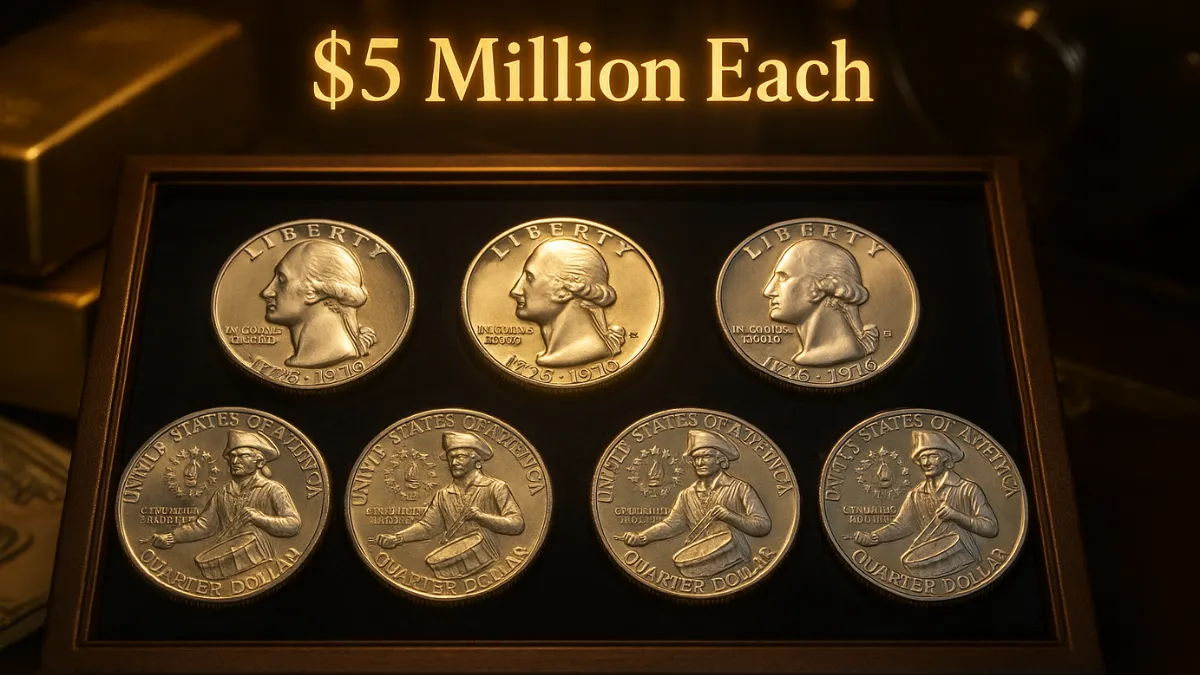Imagine finding a few coins on your kitchen counter and learning they’re worth thousands—or even millions. It may sound crazy, but it has actually happened. Some collectors will pay huge amounts for rare dimes and Bicentennial quarters. In fact, ten of these special coins combined could be worth as much as $75 million. This guide will help you spot these hidden treasures and understand why your loose change might be far more valuable than it seems.
Quick Guide – 10 Rare Coins That Could Be in Your Pocket
| Coin Type | Year | Unique Detail | Value Estimate |
|---|---|---|---|
| 1894-S Barber Dime | 1894 | Very few made (only 24) | $2 million to $3 million |
| 1968 No “S” Roosevelt Dime | 1968 | Proof coin missing the “S” | $30,000 to $50,000 |
| 1970 Tripled Die Roosevelt Dime | 1970 | Tripled lettering or numbers | $5,000 to $10,000 |
| 1982 No “P” Roosevelt Dime | 1982 | Missing the “P” mint mark | $500 to $1,500 |
| 1942-41 Mercury Dime | 1942 | Minting error between years | $1,000 to $5,000 |
| 1976 No Mint Mark Quarter | 1976 | Made in silver by mistake | $2,000 to $10,000 |
| 1976 Double Die Quarter | 1976 | Doubled “IN GOD WE TRUST” | $1,000 to $3,000 |
| 1976 Silver-Clad Bicentennial Quarter | 1976 | Special collector’s version | $500 to $1,200 |
| 2004-D Extra Leaf Quarter | 2004 | Added leaf on corn image | $300 to $6,000 |
| 1999 Georgia Experimental Quarter | 1999 | Wrong metal used | $5,000 to $10,000 |
These Rare Coins Might Be Sitting in Your Spare Change
Most people have wallets, jars, or drawers filled with coins. Usually, they’re worth their face value, but you might be holding a dime worth $10,000 or a quarter worth $5,000. Rare features, like mistakes during minting or limited releases, are what make these coins so valuable.
One of the most collected U.S. coins is the 1976 Bicentennial quarter. It was made to celebrate 200 years of American independence. But not all of these coins are valuable—only certain ones with unique errors or silver versions are worth a lot more.
The 1894-S Barber Dime That Made History
The 1894-S Barber Dime is one of the rarest U.S. coins ever made. Only 24 were produced, and fewer than 10 are known to exist today. One was given to a young girl by her father in the 1950s, and she spent it on ice cream. Years later, that very coin was found again and sold at auction for over $1.9 million.
This dime is now one of the most wanted coins among collectors, symbolizing rarity, luck, and historical value.
Roosevelt Dimes with Minting Errors – Small Flaws, Big Payouts
Most people don’t pay much attention to the little mint marks on coins, but they can make a big difference. Some Roosevelt dimes from certain years had unusual problems.
- 1968 No “S” Dime: Found in proof sets, missing the “S” stamp.
- 1982 No “P” Dime: Some dimes had no “P” mint mark.
- 1970 Tripled Die Dime: Shows doubled or tripled lines on letters or numbers.
Depending on how rare and well-kept they are, these coins could be worth hundreds to tens of thousands of dollars.
Why Some Bicentennial Quarters Are Worth More
Most 1976 quarters are worth only 25 cents. But a few rare ones are far more valuable. Here’s what to look for:
- Quarters made in silver without proper mint marks.
- Doubled lettering or numbers—these are errors that add value.
- Coins made using the wrong metal type, known as experimental planchets.
These unusual coins are tied to U.S. history and are loved by collectors for their rarity.
Where You Can Find Rare Coins
You don’t need to be a professional to find valuable coins. Here are some places to check:
- Your wallet, pockets, or change jars
- Bank coin rolls
- Old piggy banks
- Yard sales and flea markets
- Family coin collections or estate items
All it takes is curiosity and a careful look. Using a magnifying glass and a reliable coin app or guide can help you spot the special ones.
What Could They Be Worth Altogether?
If you happened to collect one of each of these 10 coins, all in perfect condition, their combined value could reach $75 million. Even finding just one rare coin could change your life.
FAQs
Are Bicentennial quarters worth anything?
Most are common and worth just a quarter. But some have rare features—like silver content or minting errors—that make them worth thousands.
How do I know if my dime is rare?
Look for things like missing mint marks, odd colors, or doubled letters and numbers. A coin scale or magnet can also help spot differences.
Should I clean my coins before selling?
It’s not a good idea. Cleaning coins can hurt their value. Collectors usually prefer them in original, even if dirty, condition.
Where can I sell rare coins?
You can sell them at coin shows, through online auctions, or licensed coin dealers. Always get a professional appraisal first.
What tools help me examine coins?
A magnifying glass, coin scale, and guidebook can help. Some coin-checking apps are also great for beginners
Final Thought
Rare coins aren’t always found in fancy displays or expensive boxes. Sometimes, they’re mixed in with your everyday change or sitting in an old jar. Though they’re small, coins like dimes and quarters from the list above could hold great value.
So, next time you get some coins back at the store, take a second look. That plain-looking coin might just be a rare gem. With patience and a sharp eye, you could discover a piece of history—and maybe even strike it rich.




